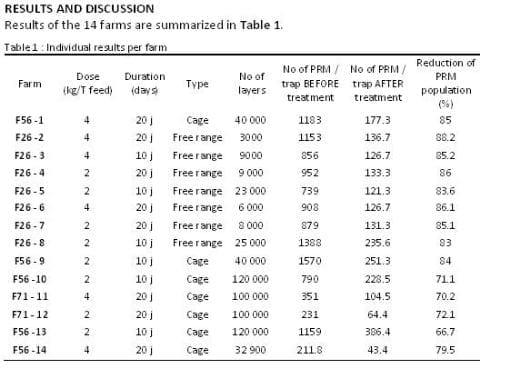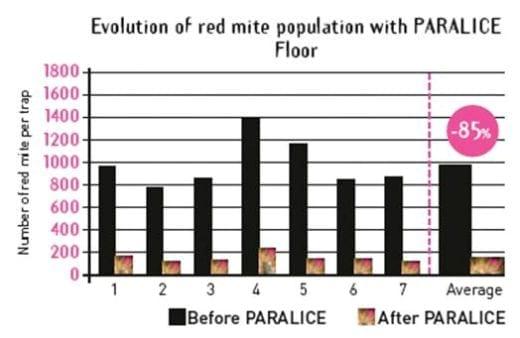Innovative Approach to Tackle Red Mite Infestation in Layer Farms
Poultry red mite (PRM), scientific name Dermanyssus gallinae, is a nocturnal blood feeding ectoparasite of birds. PRM is an acarus that requires blood of its host for development and reproduction.
Parasites consume 0.2 µl of blood in each bite. As a consequence, anaemia can appear on hens with massive infestation of PRM, leading to performance reduction (weight loss, reduced feather quality, reduced laying rate up to 25%) and, in some cases, mortality due to exhaustion and reduced immune system favouring Escherichia coli problems. Stress behaviour as higher level of preening, head scratching and feather pecking have also been reported, as well as mortal hurts and cannibalism. In addition, PRM are suspected to transfer pathogens such as Marek, Newcastle, and Zoonotic bacteria such as salmonella.

• Evolution of welfare regulations (ban of light programs, red mite repellent) and European directives on residues in eggs (MRL) are limiting the treatments during the production period thereby making it increasingly difficult to control these nocturnal acari.
• Alternative solutions have been developed by spraying natural insecticides in the houses or by blowing inert dust on the hens to destroy the red mite cuticle, ultimately leading to its dehydration. However, these techniques are time consuming; require special equipment and protection for the workers so their efficiency depends on how carefully they have been applied
INNOVATIVE SOLUTIONS TO ELIMINATE RED MITES
To cope with these disadvantages and propose a solution based on an in-feed patented non medicated mixture of aromatic extracts to farmers, PARALICE has been tested in a large scale field trial involving several French farms encountering PRM problems.
The traps were hidden below the feeders in different places of the houses during a 24 hour period. (two days before giving the treated feed to the layers to determine the initial infestation level of the house and 4 days after the end of the distribution of Paralice at the same place as the first set of traps.) The number of PRM in each trap was measured by counting under a microscope.
The tested feed additive, Paralice, was incorporated in the layer feed between 2 and 4 kg per ton of complete feed, depending on the initial infestation level in the farm. The Paralice-supplemented feed was fed to the layers for 10 to 20 days.
The effect of the treatment was evaluated by calculating the reduction of the population of PRM found in the traps after the treatment, as a percentage of the population found before the treatment (initial population).



Some interesting comments on the use of the product were also collected from the farmers :
• They all confirmed a very positive general feeling after they started Paralice. Hens appeared as quieter and the general atmosphere of the house seemed better.
• They particularly appreciated the easy use of the product as it was introduced into the feed by the feed manufacturer together with the premix. Home-mixing farmers also find it easier to incorporate the product in their mixer than to spray a liquid product on material.
• They noticed a better resistance of the hens to high temperature as some trials were run during summer with high temperatures. They especially reported a better feed consumption in the houses receiving the product in comparison with non treated houses and a lower mortality during hot periods. This last point, which remains to be validated by performance figures, could be explained by an increase of the PRM population in the non treated houses, generating discomfort for the layers, while the level of infestation in the Paralice-treated houses remained low.
• Finally, farmers did not notice any adverse effect of the inclusion of the Paralice, even at 4 kg/T, on the feed palatability.
It is a good effort of D.Marzin to provide information of the silent enemy in laying
hens.AS she mention in their article parasites consume 0.2 ul of biood in each bite,
Due to this anaemia condition produced and reduced laying rate up to 25 [percent] which
is a big loss for laying farmers.PRM also reduced immune system, favouring e. coli,
canabolisman and also transfer pathogen such as Marek, Newcastle and salmonella.
In human effects skin irritation,itching and allergies etc.
Now the question is that all other ectoparasites, PRM also have a same mode of
action ? If we used product paralice in feed, How it act inside the intestine of
laying hens ?. If infestation of parasites in hens are more, than the dose of paralice
4kg / ton is enough or we incresed the dose.How it is possible that we depend only
inside therapy of the bird and forget outside therapy against this silent enemies?.
As a whole this article is good.

Dear Sir,
Your article is very informative.I wish to know is this product effective against other poultry ecto parasites too?
Dear Sir,
Its a nice innovation but i want further information that can Red mites develop the resistance against this like for Organochlorines & Organophosphorus insecticides?
Please let us know more details on withdrawl period for the same too.
Thanks & regards,
Dr Jaydip Mulik
A good article on Red Mite Infestation in Layer Farms.















.jpg&w=3840&q=75)